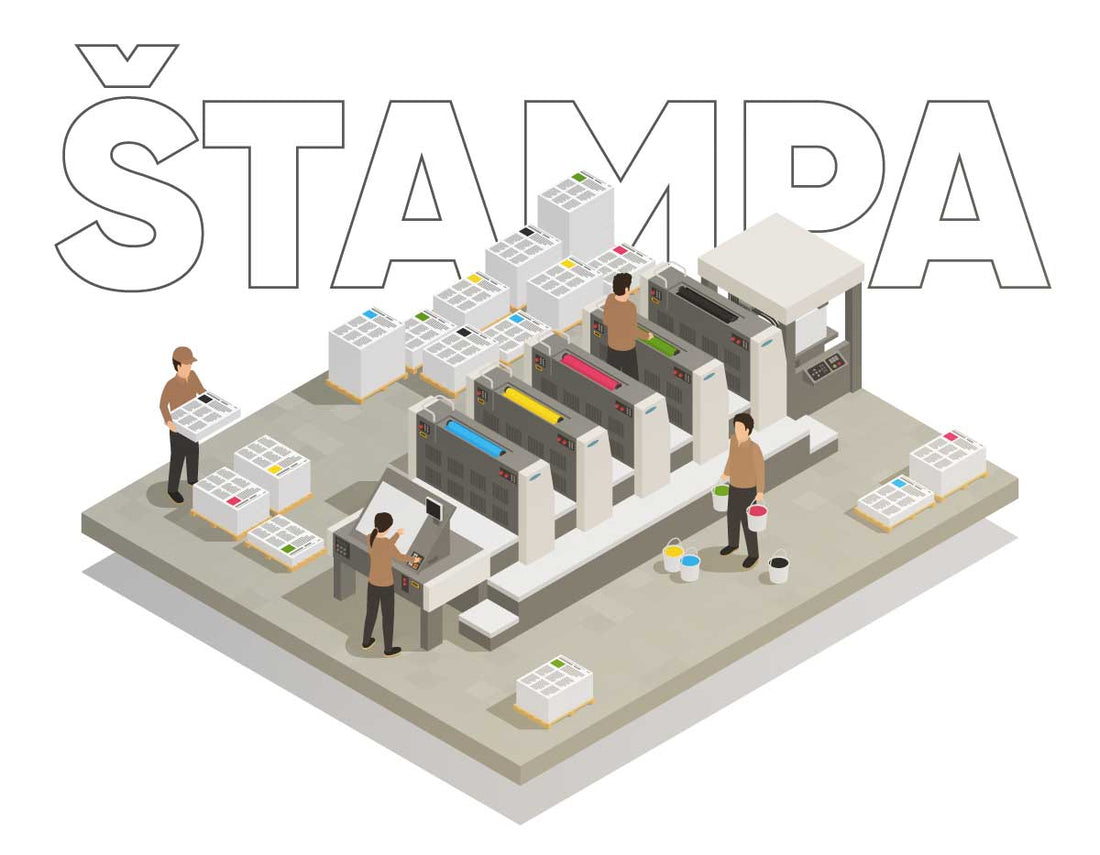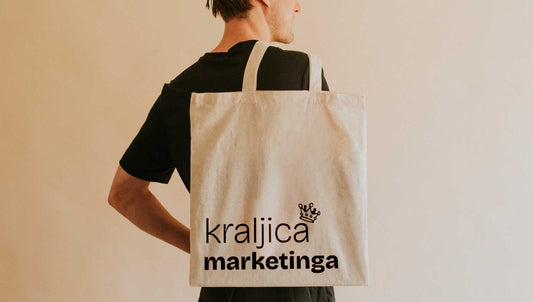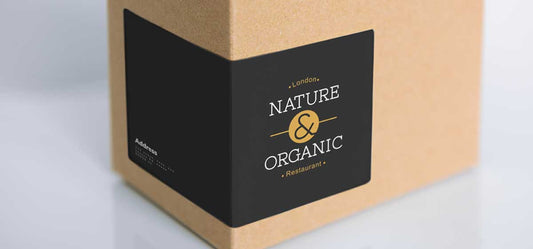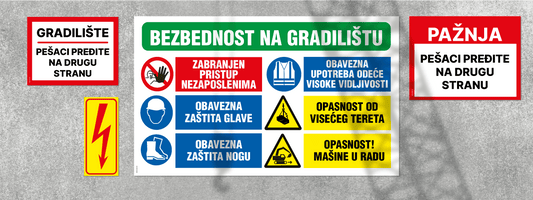
Label and Sticker Printing - The Ultimate Guide
Share
Label printing is key to a number of industries, with technologies and materials tailored to the specific needs of each sector. In the food industry, labels on OPP foil printed with flexo technique withstand temperatures from -40°C to +70°C, which is ideal for frozen products. The pharmaceutical industry uses digitally printed labels on special tear-resistant paper, allowing serialization and tracking of drugs. The automotive industry requires PET labels that withstand temperatures up to 150°C and are resistant to UV radiation. The cosmetics industry often chooses a combination of offset printing and gold printing on PVC for a luxurious look. The electronics industry uses polyamide labels resistant to temperatures up to 300°C to label components.
This diversity of applications drives innovation in printing technologies, materials and finishing techniques, enabling the production of labels that meet the stringent functional and aesthetic requirements of various sectors.
The main technologies of sticker and label printing
Although several technologies for printing labels and stickers were represented until recently, today only three technologies are dominant:

Flexo printing
The flexographic process is a representative of "high-end" printing, typical for high-volume packaging where the color is applied directly from the printing form to the printing material. Over the years, the constant development of this technique has taken place, and today we have the regular use of Anilox and UV inks in printing with the use of by far the largest range of printing materials, including heat-shrinkable synthetic materials. Over the years, the production of printing forms has also been digitized, and the quality of the print is now at a satisfactory level
| Advantages | Flaws |
|---|---|
| - High productivity and printing speed | - Limited precision of detail and design |
| - Excellent for large runs | - High initial preparation costs |
| - Good coverage of full tones | - It is not suitable for medium and small editions |
| - A large range of printing materials | - Slow machine preparation |

Offset printing
The lithographic process is representative of "flat" printing, but it is typical for high-quality prints (as a rule) of tabac printing.
| Advantages | Flaws |
|---|---|
| - Extremely high print quality | - Slower machine preparation |
| - Precise reproduction of details and fine lines | - Inflexible for design changes |
| - Economical for medium and large runs | - It is not suitable for very small editions |
| - Compatible with all finishing techniques | - Very few synthetic press materials |

Digital printing
Both paper and roll , the share of digital printing in the production of labels and stickers has been increasing for decades. Several paint application technologies (Laser, UV, Latex, Solvent) and compatibility with many synthetic materials are the carriers of this progress in this industry. As the technological development in digital printing is in line with the speed of its expansion, we can expect more and more good technological improvements in the near future.
| Advantages | Flaws |
|---|---|
| - Ideal for small and medium runs | - Higher price per unit for very large runs |
| - Ideal for variable data | - Limited selection of special colors |
| - Fast preparation and printing | - Limited range of special synthetic materials |
| - Flexibility in changing the design | - Limited use of folios |
| - No costs for making a printing form |
Thermal Transfer TT and Direct Thermal DT prints
They use heat from the head to print on thermal transfer tape or direct thermal paper, making them a subtype of digital printing. TT/DT printing is suitable for specific applications such as barcode labels.
Press materials:
Each industry has unique needs in terms of durability, visual quality, functionality and legal compliance, resulting in the application of different materials in label production.

Self-adhesive paper
Self-adhesive paper is a revolutionary material that has transformed the label printing industry, enabling a wide range of applications in different sectors. This innovative product, consisting of a paper substrate coated with an adhesive layer, offers a unique combination of functionality, versatility and economy. From retail labels to marketing materials and industrial labels , self-adhesive paper has become an indispensable resource in the world of printing and branding. Its ability to easily adapt to different printing technologies, including digital, offset and flexo methods, makes it an ideal choice for a wide range of projects and industrial applications .
| Advantages | Flaws |
|---|---|
| - Economical and widely available | - Less resistance to moisture and wear |
| - Good color absorption | - Limited outdoor durability |
| - Easily and completely recyclable |
PVC (Polyvinyl Chloride)
PVC, or polyvinyl chloride, is one of the most versatile and widely used synthetic materials in the label printing industry. This durable and flexible polymer offers exceptional resistance to moisture, chemicals and UV radiation, making it an ideal choice for applications that require longevity and durability. From the automotive industry to outdoor signage, PVC stickers have become synonymous with quality and reliability in demanding application conditions and make it an irreplaceable material in the world of branding and visual communications .
| Advantages | Flaws |
|---|---|
| - Exceptional durability and resistance to external influences | - Environmentally problematic material |
| - Flexibility and elasticity | - Potential release of harmful chemicals during production and disposal |
| - Wide range of applications |
OPP (Orientated Polypropylene)
Oriented Polypropylene (OPP) is a revolutionary material in the label printing industry, offering a unique combination of transparency, gloss and durability. This thin but extremely strong film, produced by a special stretching process, is characterized by superior dimensional stability and moisture resistance. Its compatibility with various printing technologies, including digital and flexo printing, makes OPP a versatile choice for a wide range of applications, from bottle labels to flexible packaging and from the food industry to cosmetics.
| Advantages | Flaws |
|---|---|
| - Excellent transparency and shine | - Less resistance to high temperatures |
| - Good resistance to moisture and chemicals | - Can be challenging to print without surface treatment |
| - Suitable for the food industry |
PET (Polyethylene terephthalate)
Polyethylene terephthalate, better known as PET, is a premium synthetic material that has found wide application in the label printing industry thanks to its exceptional mechanical and optical properties. This crystal clear, extremely tough and chemically resistant polymer offers unsurpassed dimensional stability and high temperature resistance. Its ability to retain shape and color under extreme conditions, along with its recyclability, makes PET an environmentally friendly and economically viable choice for demanding applications in the world of stickers and labels.
| Advantages | Flaws |
|---|---|
| - Exceptional dimensional stability | - Higher price compared to some other materials |
| - High resistance to tearing and wear | - May require special surface preparation for optimal paint adhesion |
| - Good chemical resistance | - Less resistant to UV than PP |
PES (Polyester)
Polyester, or PES, is a high-quality synthetic material that has revolutionized the label printing industry with its outstanding strength and chemical resistance. This polymer offers a unique combination of durability, thermal stability and wear resistance, making it ideal for applications in demanding industrial environments. From automotive to electronics, PES labels have become the standard for applications that require long-term durability in extreme conditions.
| Advantages | Flaws |
|---|---|
| - High UV resistance | - Higher price compared to some other materials |
| - High resistance to tearing, wear and chemicals | - May require special surface preparation for optimal paint adhesion |
| - Suitable for Solvent, Latex, UV and other printing technologies | - Less resistant to UV than PP |
The following table classifies the different types of label printing materials, printing technologies and industries where they are most commonly used:
| Type of material | Impression application technology | Application industry |
|---|---|---|
| PVC (Vinyl) | Solvent, UV, Latex | Marketing, branding, automotive industry |
| PP (Polypropylene) | Solvent, UV, Latex | Food industry, cosmetics |
| PE (Polyethylene) | Solvent, UV | Food industry, chemicals |
| PES (Polyester film) | Solvent, UV, Latex | Industrial application, technical equipment |
| Paper stickers | Offset, Digital | Retail, labels |
| Holographic stickers | Laser | Security products, branding |
| Static cling | Solvent | Temporary signs, promotions |

Finishing techniques
The printing of stickers and self-adhesive labels with its different materials is a dynamic and versatile production that is constantly evolving to meet the needs of a wide range of industries.
However, as the material is an inseparable component of the printing process, graphic finishing operations are also necessary after the printing itself.
Kiss-cut
Kiss-cut is considered cutting the label without cutting through the label carrier. This is the most common finishing operation of any self-adhesive print and is performed by machine analog (with the help of manufactured tools) or digitally (CNC or laser).
| Advantages | Flaws |
|---|---|
| - Enables making stickers of complex shapes | - An additional step in production |
| - Improves sticker functionality | - Can be challenging on thinner materials |
| - Does not damage the integrity of the material | - Requirement of the design of the form for the singing |
| - Also available in digital technology |

Die-cut
Die-cut is the stage of making stickers, which is carried out using the same techniques, machines and technologies as ripping, but with the application of stronger pressure in order to separate each sticker together with the associated paper carrier.
| Advantages | Flaws |
|---|---|
| - Enables precise shaping of stickers | - Unfavorable for all materials |
| - High precision and repeatability | - Inflexible for design changes |
| - Suitable for all editions | - It burdens the price of the product |
| - Also available in digital technology |
Lamination
Before any kind of cutting, at the client's request BOPP lamination can be performed, which, in addition to aesthetics, can also have the role of improving the structural properties or resistance of stickers and labels.
| Advantages | Flaws |
|---|---|
| - Improves the durability and resistance of the sticker | - Additional cost in production |
| - Can provide a matte or glossy effect | - It can make it difficult to recycle the material |
| - Protects the press from external influences |

Gold printing (cold or hot foil printing)
Formerly called thermography and today folio printing, the technique of applying extremely thin gold and silver foil with a hot or cold process can be performed both before and after plasticization, but certainly before other finishing operations. Today it is considered a standard technique in some industries where luxury and quality should be emphasized.
| Advantages | Flaws |
|---|---|
| - Provides a luxurious look and feel | - Relatively expensive process |
| - High visual impact | - Limited color selection (mainly gold and silver) |
| - Good wear resistance | - Can be challenging on certain materials |
Types of adhesives
Adhesives for stickers can be classified by chemical basis (water and solvent or oil) and by type of adhesion (permanent, removable and repositionable).
Chemical basis
Aqueous adhesives use water as the main medium and harden by its evaporation. Water-based adhesives are often seen as more environmentally friendly due to lower emissions of volatile organic compounds (VOCs), as opposed to solvent-based adhesives that emit higher levels of VOCs. Water-based adhesives typically offer less odor, faster initial bonding, and less risk of damaging sensitive surfaces.
Aqueous coating adhesive is produced by emulsifying acrylic or polyurethane resin in water using specialized emulsion equipment.
Advantages of water glue include versatility, environmental friendliness and affordability. Currently, many coatings use water-based adhesives, such as general water-based PA adhesives, water-based PU adhesives and film adhesives, oil waxes, as well as functional scratch repair pastes, including color pastes.
Aqueous pressure sensitive adhesives provide adequate initial adhesion, peel strength and hold ability, and are suitable for the protection of a variety of products. Thanks to quick drying and simple application, they can meet the production requirements of different products.
An oil-based adhesive is produced by dissolving acrylic acid or polyurethane in an oil-based solvent, such as toluene, DMF, methyl ethyl ketone, and the like. The advantages of this adhesive include efficient film formation, durability and high transparency. However, its disadvantage lies in the use of an oil solvent, which makes it less environmentally friendly.
Solvent-based adhesives are widely used in the packaging, tape, and medical industries due to their resistance to various environmental factors and adaptability to various surfaces.
These adhesives are suitable for both porous and non-porous materials, providing reliable adhesion after the solvent evaporates, leaving only the binder behind. They are also easier to apply than many water-based adhesives, making them a popular choice in the automotive, food packaging and graphics industries.
It is also worth mentioning flexo PET and PVC labels without glue , such as Shrink (thermo-shrinkable) and Stretch sleeve labels, which are often used on packages such as yogurt bottles. Flexo printing is also applied to OPP films that are not self-adhesive, but are locally attached with an adhesive to the product during application. Today, even paper labels that are applied to glass packaging with glue are still in use in some places.
Type of adhesion
There are also several types of adhesion and here we list only some of the most important ones:
| Type of adhesion | Description |
|---|---|
| Cling/Electrostatic | It does not use glue, but electrostatic attraction. Ideal for temporary use on smooth surfaces such as glass. Easy to install and remove without residue. |
| Permanent | Designed for a long lasting fit. It is difficult to remove and may leave a residue. Suitable for outdoor use and situations where durability is required. |
| Removable | It provides a firm grip but can be removed without damaging the surface. Ideal for short to medium term use. May leave minimal or no residue. |
| Repositionable | Allows for multiple placement and removal. Maintains stickiness over time. Suitable for situations where it is necessary to frequently move or adjust the position of the sticker. |
Conclusion
This overview covers the key aspects of printing labels, stickers and self-adhesive labels, providing insight into the advantages and disadvantages of each technology, material and finishing technique. The choice of the appropriate combination of these elements certainly depends on the specific requirements of the project, circulation, budget, desired quality and purpose of the stickers.



